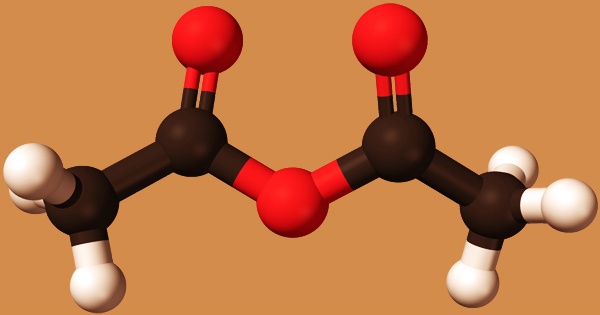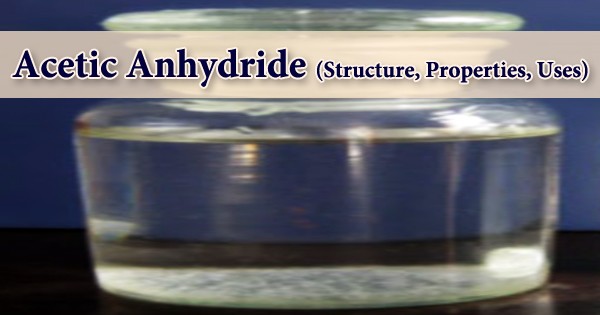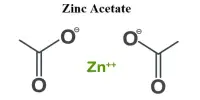The simplest isolable anhydride of a carboxylic acid, acetic anhydride (chemical formula: (CH3CO)2O), or ethanoic anhydride, commonly abbreviated Ac2O, is widely used as a reagent in organic synthesis. It’s a colorless liquid with a heavy acetic acid odor, which is created when acetic acid reacts with moisture in the air. It has potent electrophilicity due to its internal asymmetric structure. It is primarily used in organic chemistry for acetylation in the production of commercially important products, such as the conversion of cellulose-to-cellulose acetate and aspirin. It can also be used to preserve the wood.
Acetic anhydride is a versatile molecule with a nonplanar structure, like most acid anhydrides. It has a flash point of 129°F, is corrosive to metals and tissue, and has a density of 9.0 lb / gallon. It is a popular acetylation compound in the starch industry for acetylation of monoglycerides. It’s also used to make modified starches as an esterification agent. Carbonylation of methyl acetate or the reaction of ketene and acetic acid produce it.
Acetic anhydride is an acyclic carboxylic anhydride that is generated from acetic acid and serves as a metabolite and reagent. Since the leaving group is carboxylate, the carbonyl carbon atom of acetic anhydride is electrophilic, like that of most acid anhydrides. The asymmetric geometry makes one side of a carbonyl carbon atom more reactive than the other, tending to concentrate the electropositivity of a carbonyl carbon atom to one side, which may lead to acetic anhydride’s potent electrophilicity.

Heavy oxidizing agents, water, strong bases, alcohols, metals, reducing agents, amines, ammonia, nitrates, nitric acid, permanganates, phenols, sodium hydroxide, hydrogen peroxide, chromium trioxide, potassium hydroxide, perchloric acid, and ethanol are all incompatible with acetic acid anhydride. By heating potassium acetate with benzoyl chloride, the French chemist Charles Frédéric Gerhardt (1816-1856) developed acetic anhydride for the first time in 1852. Carbonylation of methyl acetate produces it:
CH3CO2CH3 + CO → (CH3CO)2O
Acetic anhydride is primarily used to convert cellulose to cellulose acetate for photographic film and other purposes. As acetic anhydride is burned, it decomposes into poisonous gases and fumes, including acetic acid fumes. With or without water, it attacks a wide range of metals. Methyl acetate is converted to methyl iodide and an acetate salt in the Tennessee Eastman acetic anhydride process. Carbonylation of methyl iodide produces acetyl iodide, which interacts with acetate salts or acetic acid to produce the final product.
Even though formic anhydride is a simpler acid anhydride, it decomposes spontaneously, especially once removed from solution. As catalysts, rhodium chloride in the presence of lithium iodide is used. The conversion is carried out in anhydrous conditions because acetic anhydride is not stable in water. Experimentally determined detection and recognition odor threshold concentrations were <600 μg/m3 (<140 ppbv) and 1.5 mg/m3 (360 ppbv), respectively. Acetic anhydride can also be made by reacting ketene (ethenone) with acetic acid at 45–55 °C and low pressure (0.05–0.2 bar) to a lesser degree.
H2C=C=O + CH3COOH → (CH3CO)2O (ΔH = −63 kJ/mol)
Acetic anhydride is a food starch esterifier that is often combined with adipic anhydride. Wacker Chemie invented the route from acetic acid to acetic anhydride via ketene in 1922, when demand for acetic anhydride increased due to the development of cellulose acetate. Acetic anhydride is normally bought, not prepared, for use in research laboratories due to its low cost. Since it interacts with water, it will not pass into the air from wet soil and water surfaces, and it is unlikely to accumulate in fish.
In humans, acetic anhydride is a serious skin irritant, and direct contact with the liquid can cause chemical burns. Some individuals have experienced allergic skin reactions. Acetylation of alcohols and amines is simple. The reaction of acetic anhydride with ethanol, for example, produces ethyl acetate:
(CH3CO)2O + CH3CH2OH → CH3CO2CH2CH3 + CH3COOH
Acetic anhydride is a common acetylation agent and solvent. It’s used to make acetylcellulose, acetylsalicylic acid, acetanilide, nitrofurane, sulfonamides, and vitamin B6, among other things. When dicarboxylic acids are exposed to acetic anhydride, they are converted to anhydrides. It’s also used to make mixed anhydrides including acetyl nitrate, which is made of nitric acid. If acetic anhydride is splashed into the eyes, it can cause severe eye irritation with burning, tearing, swelling, and light sensitivity. There have been reports of eye burns, scarring, cataracts, and temporary or permanent vision loss.
Moderate acetic anhydride vapor levels in the air cause irritation of the eyes, nose, and mouth. Nasal ulcers and pulmonary spasms are possible side effects of high acetic anhydride vapor exposure. Following very high acetic anhydride exposures in industrial accidents, breathing problems, fluid accumulation in the lungs, and death have been confirmed. During pregnancy, laboratory animals were exposed to high levels of acetic anhydride in the air, and fetal toxicity was observed.
In water, acetic anhydride dissolves to around 2.6 percent by weight. Since acetic anhydride, like most acid anhydrides, hydrolyzes to give carboxylic acids, aqueous solutions have little stability. Acetic acid is formed in this situation, and this reaction product is fully water miscible:
(CH3CO)2O + H2O → 2 CH3CO2H
Acetic anhydride is commonly used in organic syntheses, such as as a dehydrating agent in nitrations, sulfonations, and other reactions that include the removal of water. In the same way, it’s used to make aspirin (acetylsalicylic acid), which is made by acetylating salicylic acid. It’s also used as a wood preservative through autoclave impregnation to make more durable wood. To minimize heroin supply, the United Nations (UN) has urged countries to regulate acetic anhydride, a chemical that is commonly used as a “precursor” in the drug’s development.
Information Sources:
















